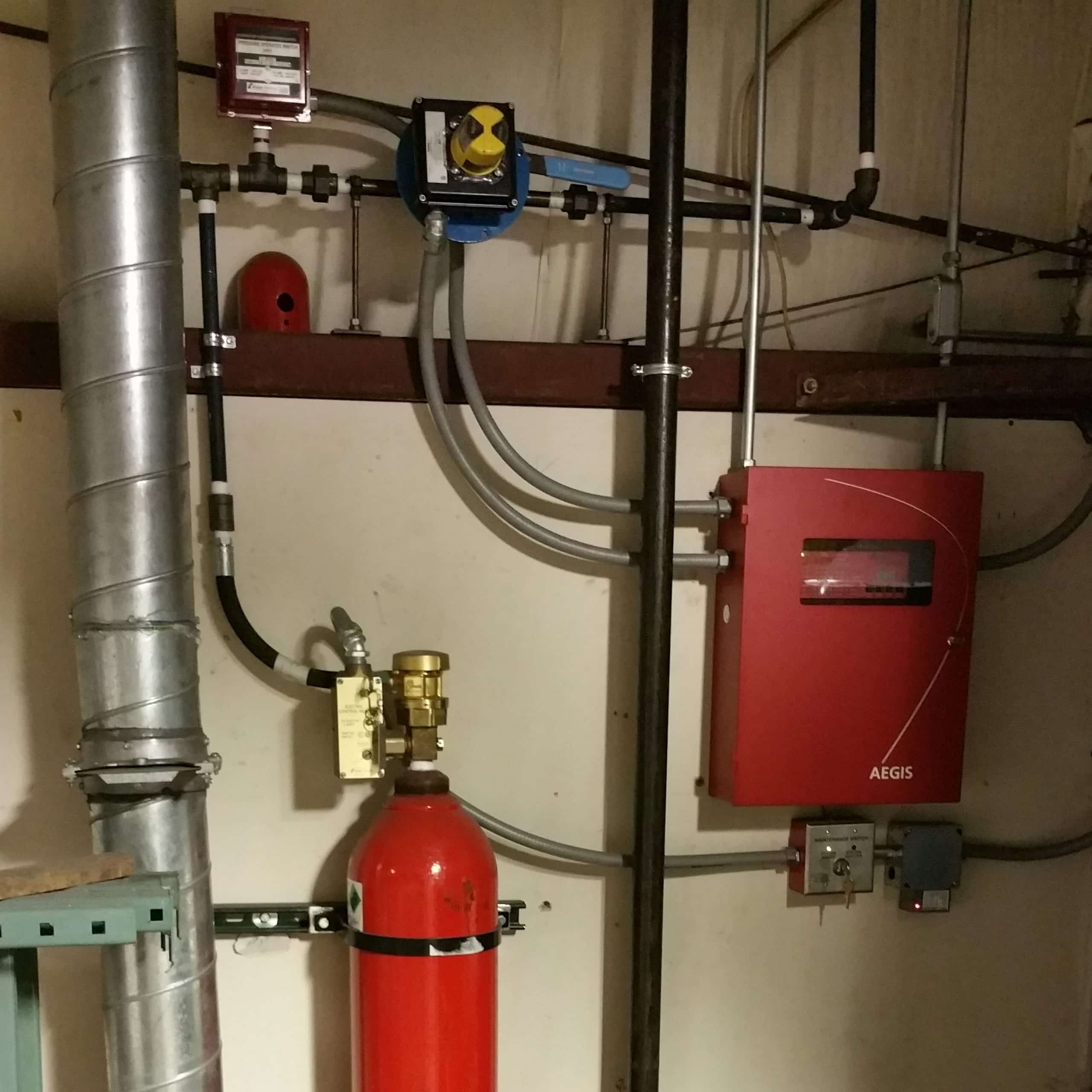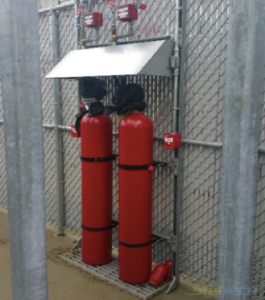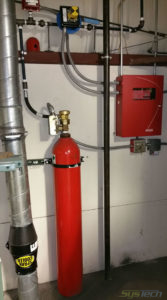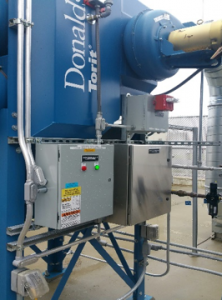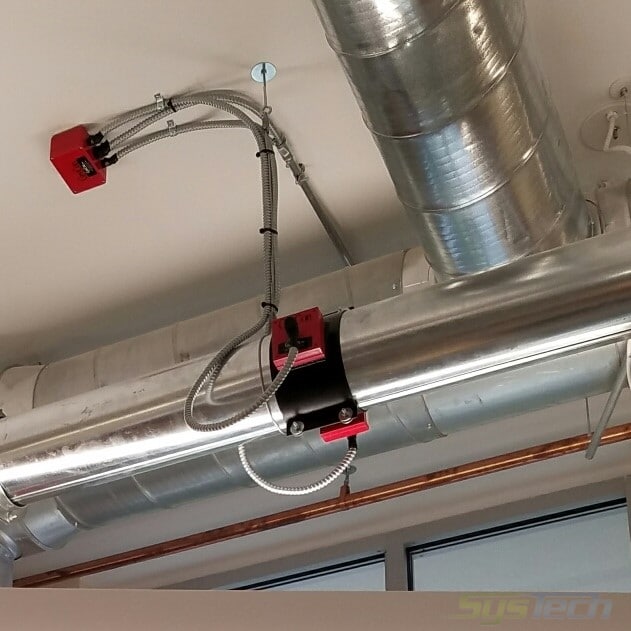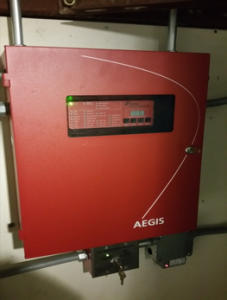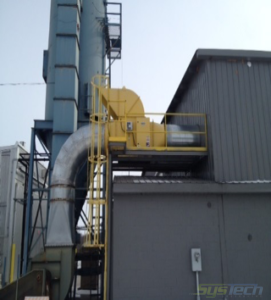Fire Protection for Dust Collectors
In conjunction with explosion protection, SysTech offers fire protection solutions for dust and fume collection systems. Fires can be incidental to a process and have a detrimental impact on worker safety and negative economic consequences to production, process equipment, and facilities.
We can help determine the best fire protection equipment for your system to comply with Code and provide a safe environment for staff. Because fire and explosion issues can overlap, reviewing each application with both mitigation solutions in mind is essential. If handling a combustible material, both protection methods need to be considered.
When is it a fire or an explosion hazard?
What is a fire?
There are three requirements to generate fire: an ignition source (sparks or embers), fuel (dust, fumes, mist), and an oxidizer (oxygen within the air). The consumption of oxygen by the “fuel” will produce the heat and light until the fuel is exhausted. An example of this is magnesium. When magnesium is exposed to an ignition source, it catches fire and burns until there is no more fuel left to burn.
What is an explosion?
Beyond the components for a fire, an explosion requires two additional requirements to occur. Those requirements are confinement of the dust and dispersion of dust inside the confined space. Confinement would be dust or fume within a vessel or collector housing, while the dispersion of dust refers to the dust particles in the airstream circulating within the dust collector or vessel. Meeting all five of these requirements at one time will result in a deflagration that releases extreme pressure and fire rapidly.
Removing any of these components from possible fire or explosion mitigates the event. Fires are not explosions, but explosions can have fires.
Fire Protection Solutions for Dust Collectors
This is determined after an analysis of the process to be protected, impacts to workers, and the utilities available.
Fire protection equipment is mainly active systems. Active systems use CO2, water, or FM200 suppression, and are designed to constantly monitor a process where a potential fire exists, using multiple heat or infrared sensors.
Once high heat is detected where a CO2 system is in place, the sensors trigger the system to dump CO2 into the process area or equipment/duct to extinguish the fire. An alternative to CO2 is water deluge suppression. Like CO2, a water system has sensors that detect heat or a fire source via infrared detection which triggers the system to dump water into the process. The water system, if applicable, is generally a less expensive option.
A third option is an FM200 suppression system. FM200 is a synthetic/chemical fire suppression gas and extinguishes a fire by removing the free radicals or heat elements from the fire triangle.
Fire prevention eliminates potential ignition sources from the airstream or environment such as sparks and embers. If a process is at risk of producing embers (slow to extinguish), then active spark mitigation or a water quench strategy could be applied. If the ignition source is a spark (quick to extinguish), passive spark mitigation using separation technology may be a better approach. Similarly, both techniques cool the sparks or embers before they contact flammable or combustible material.
When prevention techniques are applied, the possibility of a fire or explosion can be significantly decreased. However, a thorough review and understanding of a process is required before any equipment is selected or installed.
Fire Protection Systems
Fire protection systems address mitigation at the onset of a potential fire through the following means:
- CO2 Fire Suppression System – CO2 or Carbon Dioxide Fire Suppression Systems include a heat sensor, control panel, extinguishing assembly, and high (850 psi) or low (300 psi) pressure alloy tanks that store the carbon dioxide. The systems when initiated, remove the oxidizer portion of the fire triangle we referred to above. Within milliseconds of a sensor detecting heat, the control panel signals carbon dioxide release from the alloy cylinders. The introduction of the carbon dioxide into the fire zone displaces sufficient oxygen to extinguish the open flame. An important advantage of CO2 systems is the minimal clean-up required after the event as opposed to water, resulting in less production downtime. High-pressure CO2 systems are recommended where space is limited and more CO2 can be injected at a quicker rate. All systems are in accordance with the current NFPA 12, Standard for Carbon Dioxide Extinguishing Systems.
- Fire Sprinkler System– A fire sprinkler system is an active fire protection method, consisting of a water supply system having adequate pressure and flow rate to a water distribution piping system. Fire sprinkler heads along the water piping, are positioned within the collector and the duct. The sprinklers have a fusible link that melts at design temperature and is designed in accordance with NFPA 13 and NFPA 15, which require a sprinkler discharge density of 25 GPM/ft² for baghouse collectors and 0.20 GPM/ft² for ducts, hoppers, and cyclones.
Fire Prevention for Dust and Fume Collection Systems
Fire prevention systems are designed to remove ignition sources, before an event occurs, through the following means:
- Spark Detection and Extinguishing Systems – Infrared sensors or detectors are placed in the ductwork upstream of the dust or fume collection equipment to sense a spark or burning material and extinguish it with a minimal amount of water before it becomes an ignition source. These systems consist of a control panel, a varying number of extremely sensitive spark detectors and a water extinguishing assembly. The extinguishing assembly is comprised of a solenoid valve and several stainless steel nozzles. When a spark is detected, a signal is sent to the control panel causing the panel to go into an alarm state, when water is sprayed at180 degrees within the cross section of the duct, quenching any sparks.
- Spark Traps – Sometimes referred to as a “drop out” box, spark traps are an in-line duct source-capture system that removes the spark before it reaches the main containment unit, where dust, mist or fumes may be present as fuel. They cause the spark to fall out by lowering the airstream carrying velocity or they spin the spark in a centrifugal separator to remove it.
- Abort Dampers – In a dust collection system where captured and collected dust is cleaned and returned to the building, fire protection is required on the duct run between the collector and the building. Abort dampers can be placed within the duct and are used to divert and expel smoke from reentering the building.
- Static Grounding and Bonding – Static electricity is an ignition source often overlooked. In potentially flammable and combustible atmospheres, like a powder processing operation, electrostatic charges can be generated as material moves through duct work and vessels. Grounding a dust or fume collection system removes this static discharge source from the potential ignition source list.
Fire Protection System Applications
Typical fire protection applications:
- Wood Dust Collection
- Metal Grinding
- Laser and Plasma Cutting
- Weld Fume Collection
- Chemical Processing
- Alcohol Storage Facilities
- Aerosol Filling Operations
- Food Processing and Conveying
- Material Transport Systems
Should your responsible Authority Having Jurisdiction (AHJ) require additional documentation, SysTech can recommend a Risk Assessment Consultant to evaluate and document the existence or non-existence of fire hazards within your facility.
SysTech offers the most effective fire protection and prevention systems along with support services for your application.

